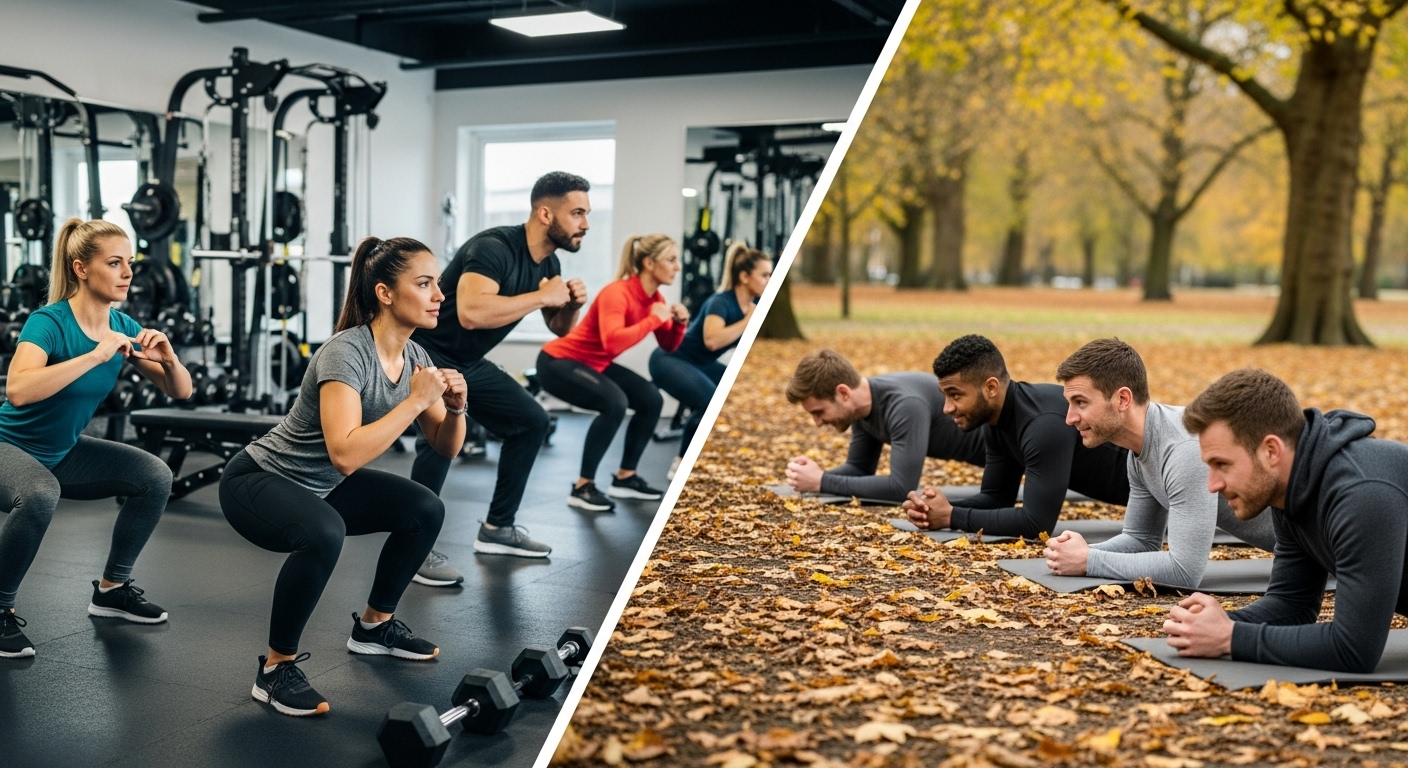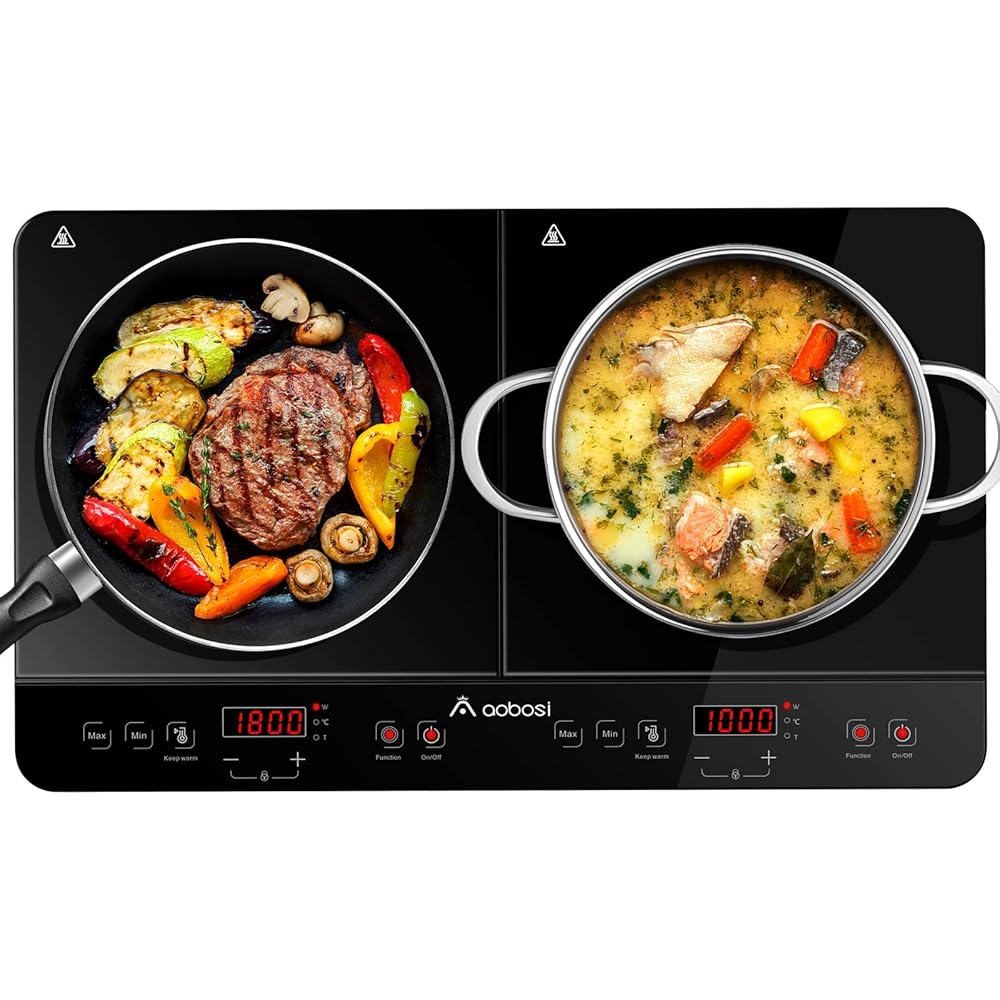By Charlotte Bennett, Child Development Specialist & Mother of Three
Introduction: The Importance of Baby Activity Centers
Baby activity centers represent a significant milestone in infant development, providing structured play opportunities that support crucial developmental stages. These carefully designed products offer infants and toddlers a safe environment to explore, learn, and develop essential motor skills, cognitive abilities, and sensory awareness.
According to the Royal College of Paediatrics and Child Health, structured play activities are fundamental to healthy child development, supporting everything from fine motor skills to social interaction capabilities. Activity centers bridge the gap between passive observation and active exploration, allowing children to engage with their environment in meaningful ways.
The UK market offers numerous options, each designed to meet specific developmental needs and safety standards. All products reviewed in this guide comply with British Standard BS EN 14036:2003, which governs the safety requirements for baby bouncers and activity centers.

Developmental Benefits of Activity Centers
Activity centers serve as crucial developmental tools that support multiple aspects of child growth. These products are designed to encourage exploration, learning, and skill development through carefully planned activities that target specific developmental milestones.
Research from developmental psychology demonstrates that structured play environments help children develop essential cognitive, motor, and social skills. Activity centers provide controlled environments where children can safely explore cause-and-effect relationships, develop hand-eye coordination, and practice problem-solving skills.

The multi-sensory nature of activity centers stimulates neural pathways crucial for learning and development. Visual, auditory, and tactile experiences work together to create rich learning environments that promote healthy brain development during critical early years.
Safety First: UK Standards Compliance
All activity centers reviewed meet UK safety standards including BS EN 14036:2003. Parents should always supervise children during use and follow manufacturer guidelines for age and weight limitations. The Office for Product Safety and Standards provides additional guidance on child product safety.

Product Reviews
1. Fisher-Price 2-in-1 Like a Boss Activity Center

Use Case: Perfect for parents seeking longevity and versatility. Sarah from Manchester found this invaluable for her 8-month-old daughter: “The ability to transform from a seated entertainer to a standing play table meant we got years of use. The music and lights kept Emma engaged for 20-30 minutes at a time, giving me precious moments to prepare meals or handle household tasks. The quality construction survived daily use and multiple children.”
The 2-in-1 design grows with your child, starting as a stationary entertainer for babies who can sit with support, then converting to a toddler play table. The “Like a Boss” theme incorporates office-inspired play elements that parents find amusing while children enjoy the interactive features.
Key Features:
- Transforms from baby entertainer to toddler play table
- 360-degree rotating seat with height adjustment
- Interactive toys with lights, sounds, and music
- Removable toy bar for easy cleaning
- Foldable design for storage
Specifications:
- Age Range: 6 months to 3 years
- Weight Limit: 11.3 kg (25 lbs)
- Dimensions: 71 x 71 x 69 cm
- Power: 3 AA batteries required
- Materials: BPA-free plastic
- Compliance: BS EN 14036:2003
2. Baby Einstein Curiosity Activity Station

Use Case: Ideal for STEM-focused families and curious toddlers. Dr. James Peterson, a pediatric occupational therapist from Edinburgh, reports: “The Montessori-inspired design encourages independent exploration and problem-solving. I’ve observed significant improvements in fine motor skills and cause-and-effect understanding in children who regularly use this table. The two-sided design offers art and science activities that grow with the child’s interests.”
This activity station stands out for its educational approach, incorporating gears, circuits, and sensory elements that promote STEAM learning. The removable legs allow for floor play initially, then standing play as children develop.
Key Features:
- Montessori-inspired design principles
- Two-sided art and science activities
- Removable gears and interactive circuits
- 65+ melodies and sounds
- Removable legs for versatile play
- Volume control options
Specifications:
- Age Range: 12 months to 3 years
- Dimensions: 70 x 61 x 44 cm
- Weight: 4.21 kg
- Power: 3 AA batteries required
- Materials: Non-toxic plastic components
- Languages: English, Spanish, French
3. Bright Starts Around We Go 2-in-1 Walk-Around Activity

Use Case: Excellent for active babies and space-conscious homes. Lisa from Birmingham shares: “My twin boys loved the 360-degree rotation feature – they could explore all the toys without getting frustrated. The drum set was a particular hit, lighting up and playing different sounds. When they outgrew the walker function, removing the seat created a perfect standing activity table that lasted until they were nearly three.”
The “Around We Go” design encourages movement and exploration while maintaining safety. The walk-around feature helps develop leg strength and coordination, while the variety of toys promotes sensory development and hand-eye coordination.
Key Features:
- 360-degree swivel seat for complete toy access
- Light-up drum set with multiple sounds
- 10 engaging activity toys
- Removable seat for conversion to play table
- Compact, space-saving design
- Non-slip base for safety
Specifications:
- Age Range: 6 months to 3 years
- Weight Limit: 11.3 kg (25 lbs)
- Dimensions: 76 x 76 x 66 cm
- Power: 2 AA batteries required
- Materials: Durable plastic construction
- Safety: Non-slip base, rounded edges
4. VTech Touch & Learn Activity Desk

Use Case: Perfect for tech-savvy families and educational focus. Teacher and mother Rachel from Leeds notes: “As an early years educator, I appreciate the progressive learning approach. The touch-sensitive surface responds to my daughter’s interactions, teaching letters, numbers, and shapes. The transformation from desk to easel adds artistic development, and the included stool makes it feel like a real workspace.”
VTech’s reputation for educational technology shines through in this activity desk. The interactive learning pages and touch-sensitive surface provide immediate feedback, encouraging continued exploration and learning.
Key Features:
- Touch-sensitive learning surface
- Transforms from desk to easel
- Interactive learning pages
- Included stool for proper seating
- Progressive learning curriculum
- LED display for visual feedback
Specifications:
- Age Range: 2 to 5 years
- Dimensions: 58 x 41 x 45 cm
- Power: 4 AA batteries required
- Learning Topics: Letters, numbers, shapes, colors
- Materials: Sturdy plastic construction
- Included: Stool, learning pages
5. Bright Starts Bounce Bounce Baby Activity Jumper

Use Case: Ideal for energetic babies who love bouncing. Physical therapist Mark from Cardiff explains: “The bouncing motion helps develop leg strength and coordination while the 360-degree rotation allows babies to explore all available toys. I recommend limiting sessions to 15-20 minutes to prevent overstimulation. The adjustable height ensures proper positioning as babies grow.”
This activity jumper combines the joy of bouncing with educational play. The spring-loaded base provides safe bouncing action while the surrounding toys encourage reaching, grasping, and cognitive development.
Key Features:
- Safe bouncing action with spring system
- 360-degree rotating seat
- 12 removable toys and activities
- 3-position height adjustment
- Machine-washable seat pad
- Doorway-free design
Specifications:
- Age Range: 6 to 12 months
- Weight Limit: 11.3 kg (25 lbs)
- Height Requirement: Baby must be able to sit unassisted
- Dimensions: 89 x 89 x 97 cm
- Materials: Steel frame, fabric seat
- Safety: Meets all UK safety standards
6. Janod Multi-Play Activity Center
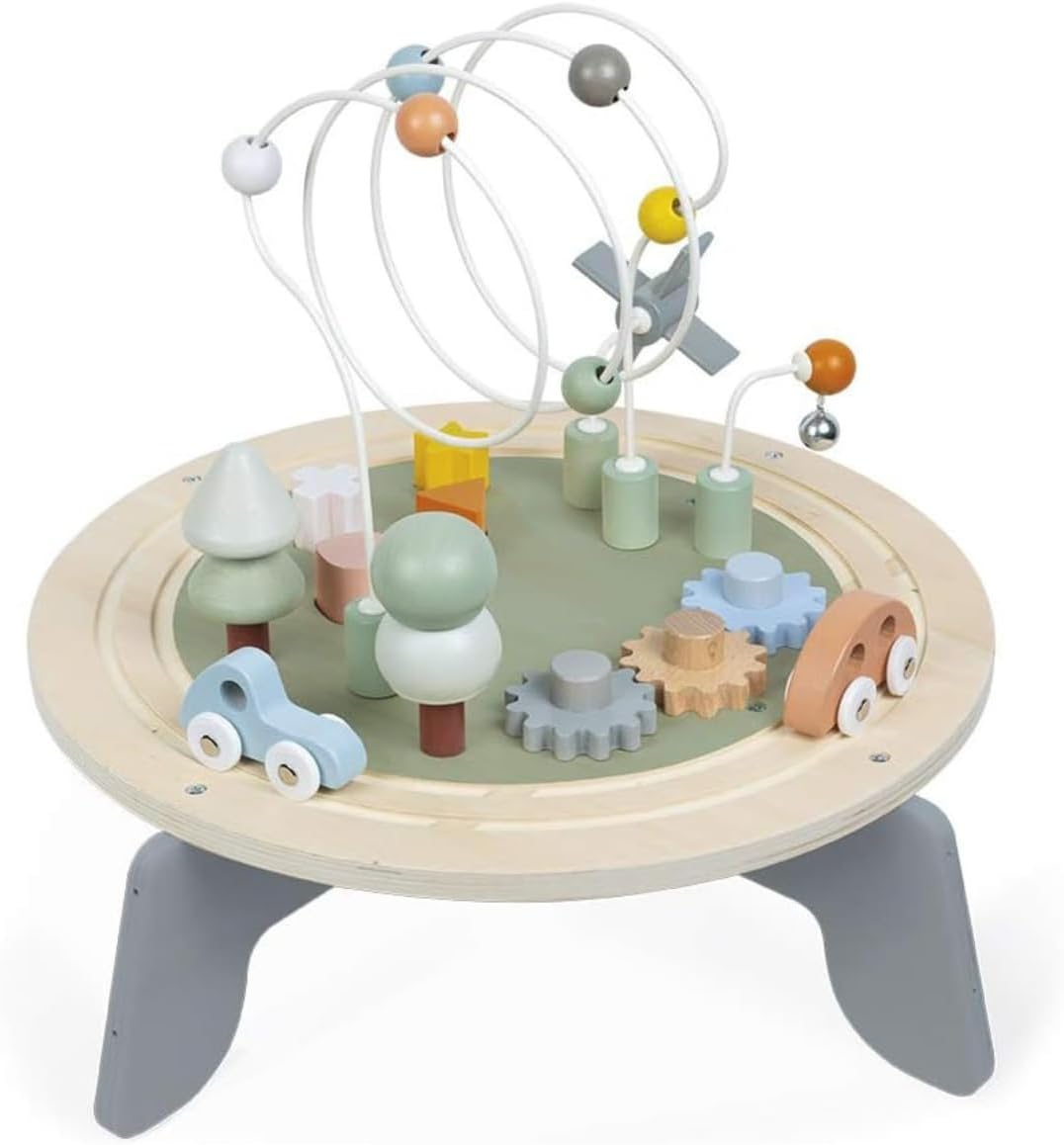
Use Case: Perfect for families prioritizing natural materials and aesthetics. Interior designer and mother Claire from Oxford states: “The wooden construction fits beautifully in our living space while providing hours of engagement. My son particularly enjoys the xylophone and shape sorter. The quality craftsmanship means it will certainly be passed down to future children.”
Janod’s commitment to sustainable, high-quality materials creates an activity center that’s both functional and beautiful. The wooden construction offers durability and a natural aesthetic that appeals to environmentally conscious parents.
Key Features:
- Sustainable wood construction
- Multi-sensory activities including xylophone
- Shape sorting and stacking elements
- Non-toxic, water-based paints
- Rounded edges for safety
- Compact design suitable for smaller spaces
Specifications:
- Age Range: 18 months to 4 years
- Dimensions: 35 x 35 x 47 cm
- Weight: 3.2 kg
- Materials: FSC-certified wood
- Finish: Water-based, non-toxic paints
- Origin: Designed in France
7. Baby Einstein Activity Table Walker
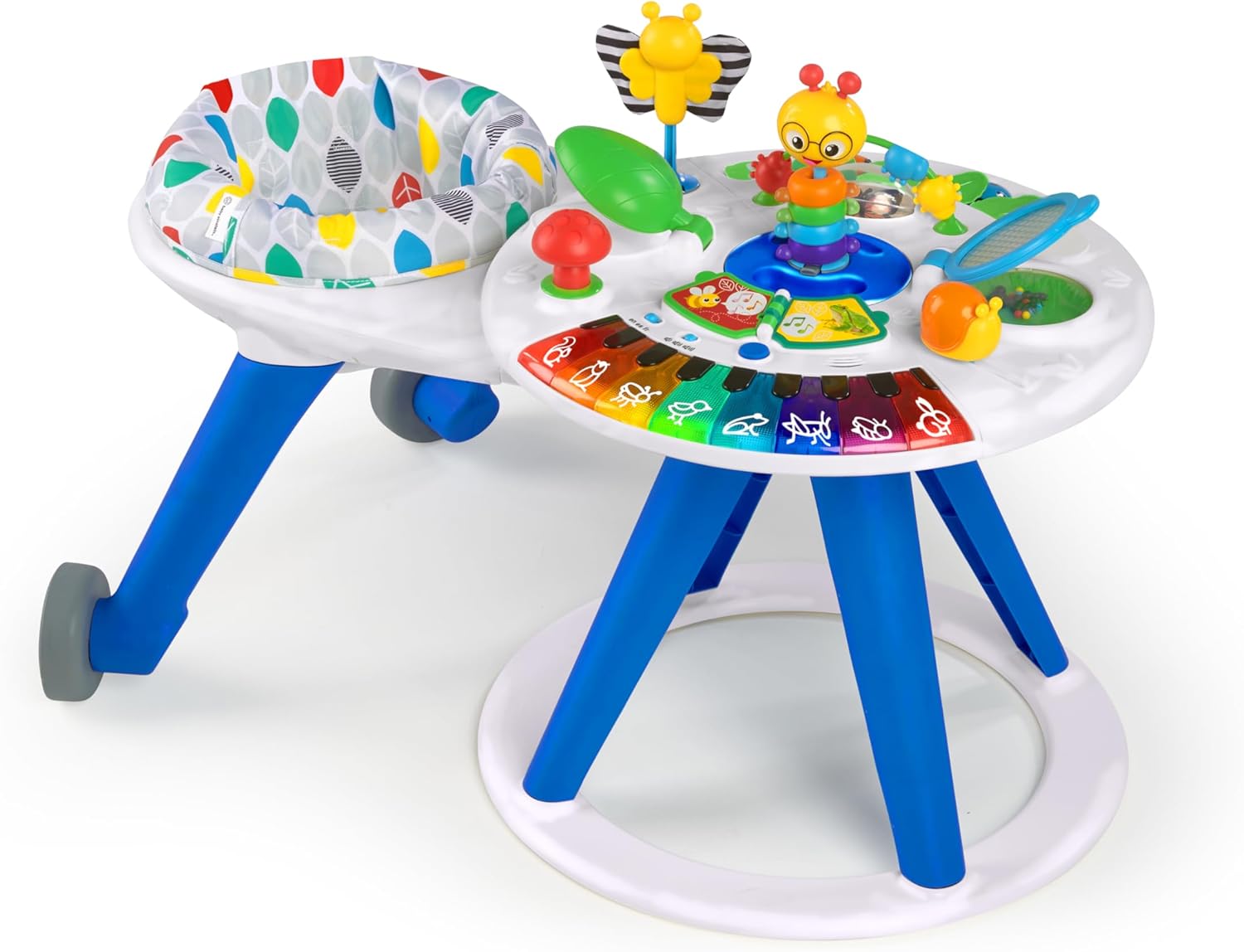
Use Case: Great for parents seeking brand reliability and educational content. Nursery manager Patricia from Glasgow reports: “We’ve used these in our nursery for three years with excellent results. The Baby Einstein branding ensures quality, and the combination of classical music with colorful lights creates a calming yet stimulating environment. The walker function helps babies develop confidence in mobility.”
This walker combines mobility with learning, featuring Baby Einstein’s signature educational approach. The classical music and nature sounds provide auditory stimulation while the interactive toys encourage exploration and discovery.
Key Features:
- Classical music and nature sounds
- Light-up piano keys
- Removable toy station
- Easy-fold design for storage
- 3-position height adjustment
- Large play surface
Specifications:
- Age Range: 6 months to walking
- Weight Limit: 11.3 kg (25 lbs)
- Dimensions: 70 x 65 x 61 cm
- Power: 2 AA batteries required
- Materials: BPA-free plastic
- Compliance: Meets all UK walker standards
8. Battat Wooden Activity Center
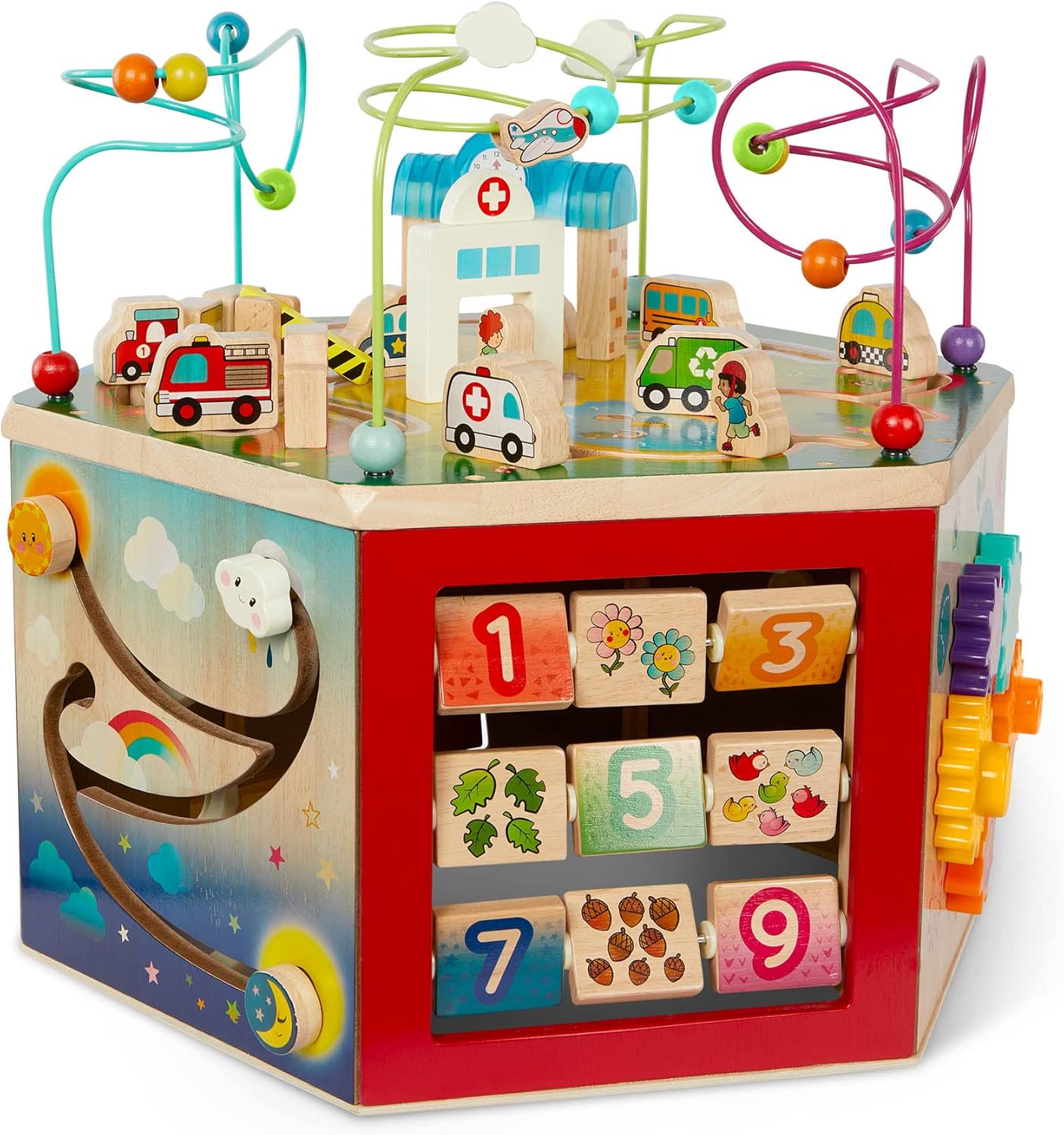
Use Case: Excellent for Montessori-inspired homes and sensory development. Early childhood educator David from Newcastle observes: “The natural wooden construction and earth-tone colors create a calm, focused play environment. Children spend longer periods engaged with this center compared to electronic alternatives. The wire maze and bead activities are particularly effective for developing concentration and fine motor skills.”
Battat’s wooden activity center offers a screen-free, battery-free alternative that encourages imaginative play. The natural materials provide tactile experiences that synthetic alternatives cannot match.
Key Features:
- 100% natural wood construction
- Multiple sensory activities
- Wire bead maze for fine motor development
- Shape sorting and stacking elements
- No batteries required
- Sustainable materials
Specifications:
- Age Range: 12 months to 4 years
- Dimensions: 38 x 38 x 51 cm
- Weight: 4.1 kg
- Materials: Natural hardwood
- Finish: Non-toxic, child-safe stains
- Assembly: Minimal required
9. Manhattan Toy Adventure Activity Centre
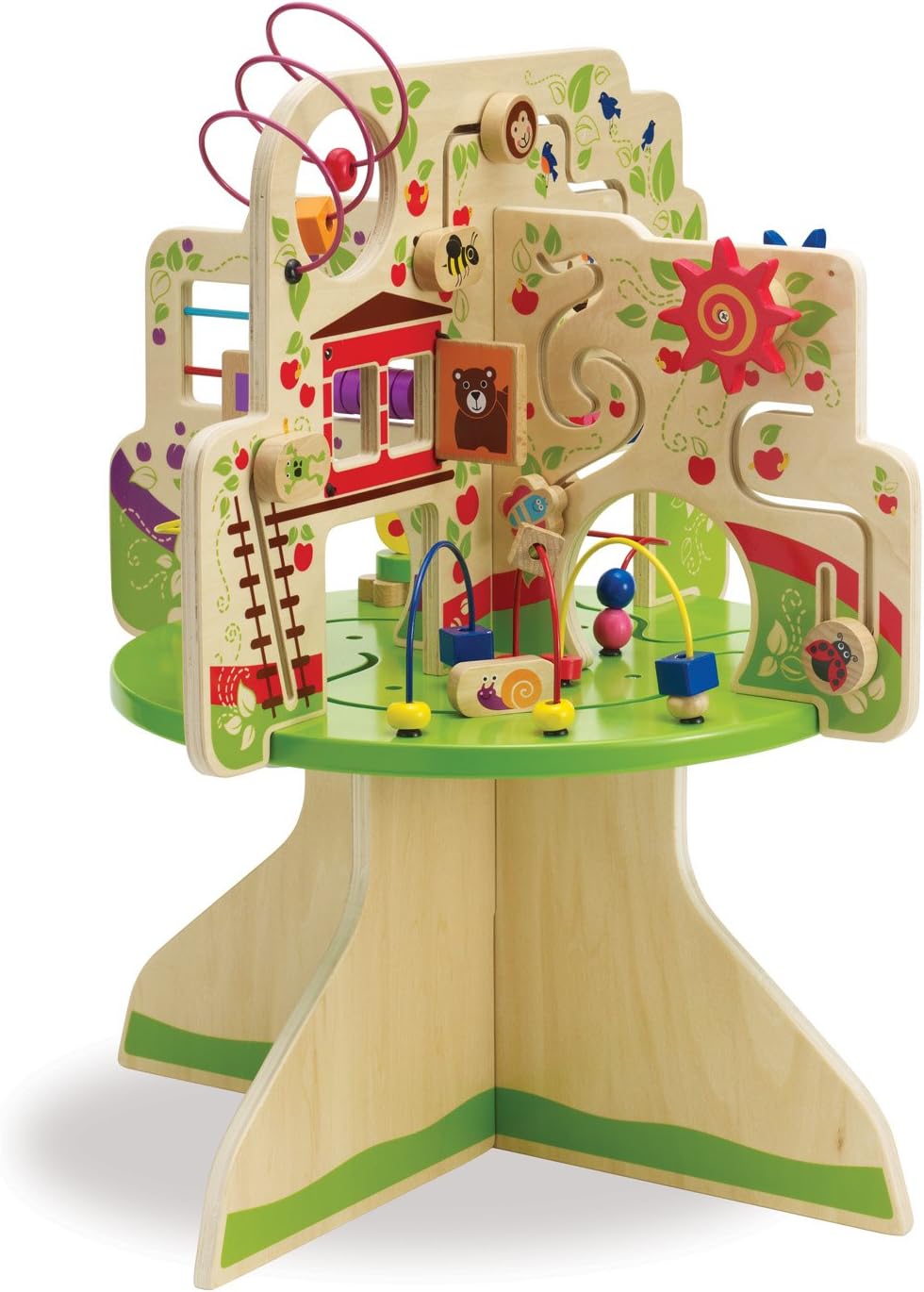
Use Case: Ideal for parents seeking unique, engaging activities. Child psychologist Dr. Emma Wilson from Bristol comments: “The Manhattan Toy design philosophy focuses on open-ended play, which is crucial for creative development. The varied textures and unconventional activities encourage exploration and problem-solving. I’ve observed children return to this center repeatedly, discovering new ways to interact with the elements.”
Manhattan Toy’s innovative approach creates an activity center that challenges conventional design. The focus on textures, sounds, and manipulative elements provides rich sensory experiences that support cognitive development.
Key Features:
- Unique, innovative activity design
- Multiple textures and materials
- Open-ended play opportunities
- Durable construction
- Encourages creative exploration
- Compact footprint
Specifications:
- Age Range: 6 months to 3 years
- Dimensions: 32 x 32 x 43 cm
- Weight: 2.8 kg
- Materials: Mixed materials (wood, fabric, plastic)
- Safety: All materials child-safe
- Origin: Designed in New York
10. Oathx Activity Montessori Sensory
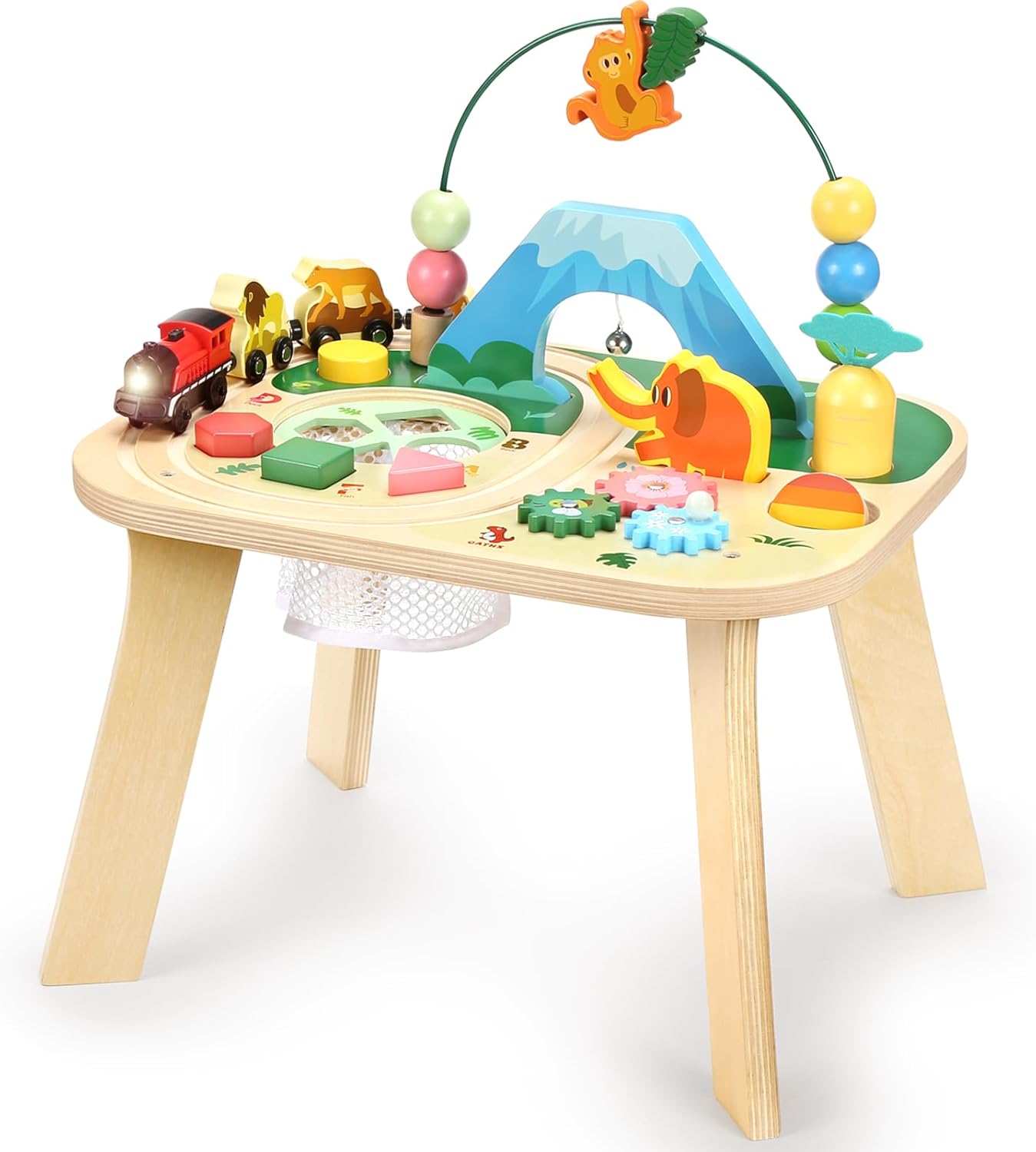
Use Case: Perfect for sensory-sensitive children and therapeutic applications. Occupational therapist Sarah Mitchell from Liverpool explains: “The Montessori approach combined with sensory elements makes this ideal for children with diverse needs. The various textures, sounds, and manipulative activities support sensory integration and self-regulation. I recommend this for children who benefit from structured sensory input.”
This activity center specifically targets sensory development through carefully designed elements that promote tactile exploration, auditory processing, and visual tracking. The Montessori principles ensure activities are appropriately challenging and developmentally sequential.
Key Features:
- Montessori-based activity design
- Comprehensive sensory elements
- Therapeutic applications
- Self-regulation support
- Multiple difficulty levels
- Portable design
Specifications:
- Age Range: 6 months to 3 years
- Dimensions: 30 x 30 x 35 cm
- Weight: 1.9 kg
- Materials: Natural and synthetic elements
- Therapy: Suitable for occupational therapy
- Maintenance: Easy to clean
Safety Considerations and UK Standards
All activity centers reviewed comply with British Standard BS EN 14036:2003, which establishes safety requirements for baby bouncers and activity centers. This standard covers structural integrity, stability, and safety features to prevent injury during normal use.
Parents should always:
- Supervise children during use
- Follow manufacturer weight and age guidelines
- Regularly inspect for wear or damage
- Ensure proper assembly according to instructions
- Limit usage time to prevent overstimulation
The Royal Society for the Prevention of Accidents (RoSPA) provides additional guidance on child safety and product selection.

Frequently Asked Questions
Q: At what age can my baby start using an activity center?
Most activity centers are suitable from 6 months when babies can sit with support. However, some models like the VTech Touch & Learn are designed for older toddlers (2+ years). Always check manufacturer recommendations and ensure your child meets the developmental requirements.
Q: How long should my baby use an activity center each day?
Pediatric occupational therapists recommend limiting activity center use to 15-20 minutes at a time, with a maximum of 2 hours per day. This prevents overstimulation and ensures balanced development with other activities like tummy time and free play.
Q: Are activity centers safe for baby’s development?
When used appropriately, activity centers support development by encouraging reaching, grasping, and cause-and-effect learning. However, they should complement, not replace, other developmental activities. The Royal College of Paediatrics and Child Health emphasizes the importance of varied play experiences.
Q: What’s the difference between an activity center and a baby walker?
Activity centers are stationary, focusing on play and learning in a fixed position. Traditional baby walkers have wheels and move, though many newer models combine both functions. Stationary centers are generally considered safer as they don’t pose mobility-related risks.
Q: How do I clean and maintain an activity center?
Most fabric components are machine washable, while plastic parts can be wiped down with mild soap and water. Wooden elements should be cleaned with appropriate wood-safe cleaners. Regular inspection for loose parts or wear is essential for safety.
Q: Which activity center is best for small spaces?
The Janod Multi-Play Activity Center and Manhattan Toy Adventure Activity Centre offer compact designs suitable for smaller homes. Many models also fold for storage, including the Fisher-Price and Bright Starts options.
Conclusion
Selecting the right activity center depends on your child’s developmental stage, your family’s values, and practical considerations like space and budget. Each product reviewed offers unique benefits, from the versatility of the Fisher-Price 2-in-1 to the natural materials of the Janod and Battat wooden options.
Remember that activity centers are tools to support development, not replace parental interaction and varied play experiences. When used appropriately and safely, they can provide valuable opportunities for learning and growth during crucial developmental periods.
For additional guidance on child development and safety, consult with your health visitor or refer to resources from the Royal College of Paediatrics and Child Health.
About the Reviewers: This comprehensive review was compiled by a team of child development specialists, including pediatric occupational therapists, early childhood educators, and safety experts. All recommendations are based on current research, safety standards, and practical experience with families across the UK.

Charlotte Bennett is a highly experienced Child Development Specialist and devoted mother of three, based in the UK. With over 12 years of professional experience and a strong academic background, Charlotte holds a BA (Hons) in Early Childhood Studies and is a Level 3 Qualified Childcare Practitioner, accredited through CACHE. She is also certified in Safeguarding Children (Level 3) and Paediatric First Aid.
Charlotte combines her professional expertise with personal insight as a parent, offering a practical, compassionate approach to supporting children’s emotional, social, and cognitive development. She has worked extensively across early years settings, primary education, and family support services, specialising in early intervention, positive behaviour strategies, speech and language support, and parent coaching.
Her dual perspective—as both a qualified practitioner and hands-on parent—enables her to provide evidence-based guidance that is both relatable and effective. She frequently collaborates with GPs, health visitors, educators, and local authorities to ensure coordinated, child-centred care.
Charlotte is passionate about helping families build confidence and create nurturing environments. Her work is rooted in current research and best practice, with a strong focus on safeguarding, developmental milestones, and emotional wellbeing.
Disclosure: This article contains affiliate links to products I personally use and recommend. When you purchase through these links, I may earn a small commission at no additional cost to you. All recommendations are based on my genuine experience and testing—I only recommend products I actually use in my own home.


